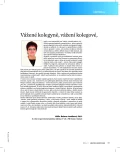Non-image forming effects of light: chronobiologic therapy
Authors:
A. Fuksa
Published in:
Geriatrie a Gerontologie 2017, 6, č. 2: 87-90
Category:
Review Article
Overview
Non-image forming effects of light such as melatonin decrease, shift of circadian phase or alteration of circadian amplitude are mediated by a little-known type of photoreceptor – intrinsically photosensitive retinal ganglion cells (ipRGCs). These are matched to properties of outdoor light and allow mammals to synchronize their circadian rhythm to 24-hour period of day/night cycle. With exceptions, artificial lighting in buildings does not exceed the threshold of this effect. The need of light grows with age. Weak stimulus may lead to loss of synchronization. Properly-timed (morning) light of suitable intensity (thousands of lux) and appropriate spectral composition (cold tone) may supplement the missing light information and re-establish the synchronization. Bright light is used therapeutically to treat for example depression or seasonal affective disorder. As an environmental measure, bright light is used in medical and nursing facilities.
KEYWORDS:
phototherapy – chronobiology – photosensitive retinal ganglion cells – circadian rhythm – depression – dementia – Alzheimer´s disease
Sources
1. DIN SPEC 5031-100 : 2015-08. Fyzika optického záření a osvětlovací technika: Část 100: Nevizuální účinky transokulárního světla na člověka – veličiny, značky a účinná spektra. Berlin: Beuth Verlag 2015.
2. Fuksa A. Světlo a biologické hodiny. Světlo 2010; 6 : 56–58.
3. DIN V 5031-100 : 2009. Fyzika optického záření a osvětlovací technika: Část 100: Nevizuální účinky transokulárního světla na člověka – veličiny, značky a účinná spektra. Berlin: Beuth Verlag 2009.
4. Jamie M. Zeitzer, Derk-Jan D, et al. Sensitivity of the human circadian pacemaker to nocturnal light: melatonin phase resetting and suppression. Journal of Physiology 2000; 526(3): 695–702.
5. Šmotek M, et al. Prokognitivní účinek umělého osvětlení: Objektivní a subjektivní charakteristiky vigility u zdravých dospělých po expozici světlu různé vlnové délky. 59. česko-slovenská psychofarmakologická konference. Jeseník, 2017.
6. ČSN EN 12464-1 : 2012. Světlo a osvětlení – osvětlení pracovních prostorů: Část 1: Vnitřní pracovní prostory. Praha: ÚNMZ 2012.
7. DIN SPEC 67600 : 2013-04. Biologicky účinné osvětlení – směrnice pro návrh. Berlin: Beuth Verlag 2013.
8. Sust, et al. Improved quality of life for resident dementia patients: St. Katharina research project in Vienna. Zumtobel Research 2012.
9. Forbes D, et al. Light therapy for improving cognition, activities of daily living, sleep, challenging behaviour, and psychiatric disturbances in dementia. Cochrane Database of Systematic Reviews (online). 2014, Chichester, UK: John Wiley.
10. Sekiguchi H, et al. Bright light therapy for sleep disturbance in dementia is most effective for mild to moderate Alzheimer‘s type dementia: a case series. Psychogeriatrics (online). 2017; 1 : 1–7.
Labels
Geriatrics General practitioner for adults Orthopaedic prostheticsArticle was published in
Geriatrics and Gerontology

2017 Issue 2
Most read in this issue
- Delirium – new knowledge and experiences for clinical practice
- Palliative care at post-acute care facilities
- Pulmonary nocardiosis in a geriatric patient
- The cognitive disorder is not always dementia
